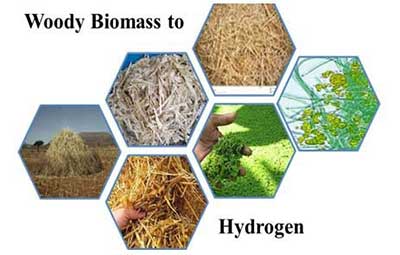Relevance: GS-3: Conservation, environmental pollution and degradation.
Key phrases: Biomass, hydrogen, Gasification, Pyrolysis, Renewable Source, Carbon neutral, biomass energy.
Why in News?
- The country’s first commercial-scale biomass-based hydrogen plant is coming up in the Khandwa district of Madhya Pradesh. The plant will produce a tonne of hydrogen per day, from 30 tonnes of biomass feedstock.
What is Biomass?
- Biomass can be described as all material that was or is a part of a living organism. For renewable energy applications, however, the definition of biomass is usually limited to include only materials that are plant-derived such as agricultural residues.
Biomass sources for energy include:
- Wood and wood processing wastes: firewood, wood pellets, and wood chips, lumber and furniture mill sawdust and waste, and black liquor from pulp and paper mills
- Agricultural crops and waste materials: corn, soybeans, sugar cane, switchgrass, woody plants, and algae, and crop and food processing residues
- Biogenic materials in municipal solid waste: paper, cotton, and wool products, and food, yard, and wood wastes
- Animal manure and human sewage
Process used for Hydrogen production from Biomass
Gasification: Gasification is a process that converts organic or fossil-based carbonaceous materials at high temperatures (>700°C), without combustion, with a controlled amount of oxygen and/or steam into carbon monoxide, hydrogen, and carbon dioxide. The carbon monoxide then reacts with water to form carbon dioxide and more hydrogen via a water-gas shift reaction. Absorbers or special membranes can separate the hydrogen from this gas stream.

Pyrolysis is the gasification of biomass in the absence of oxygen. In general, biomass does not gasify as easily as coal, and it produces other hydrocarbon compounds in the gas mixture exiting the gasifier; this is especially true when no oxygen is used. As a result, typically an extra step must be taken to reform these hydrocarbons with a catalyst to yield a clean syngas mixture of hydrogen, carbon monoxide, and carbon dioxide. Then, just as in the gasification process for hydrogen production, a shift reaction step (with steam) converts the carbon monoxide to carbon dioxide. The hydrogen produced is then separated and purified.
Why hydrogen production from Biomass is Important?
- Renewable Source: Biomass is a renewable source of energy because it can be renewed by planting more trees and plants. So hydrogen production from biomass is a renewable fuel. India being a predominantly agriculture-based country, the availability of biomass from agriculture residue can be leveraged for producing hydrogen.
- Reduce GHGs: Plants consume carbon dioxide from the atmosphere as part of their natural growth process as they make biomass, off-setting the carbon dioxide released from producing hydrogen through biomass gasification and resulting in low net greenhouse gas emissions.
- Cost effective: Hydrogen produced through the biomass pathway could be a viable, cost effective and efficient alternative for India. Power generation from biomass is not new to India however, hydrogen from biomass is an area which although nascent, holds great promise.
- Abundant sources: India being a predominantly agriculture-based country, the availability of biomass from agriculture residue can be leveraged for producing hydrogen. There is more biomass available than is required for food and animal feed needs.
- Carbon neutral: Although hydrogen is a clean fuel, with multiple applications across industry, power, and mobility, its production from fossil fuels dilutes its potential as a decarbonizing vector. However, hydrogen produced from renewable sources is emission free and is considered a green fuel. One of the promising ways to produce this green hydrogen could be through biomass - a carbon neutral feedstock.
Way Forward:
- Key challenges to hydrogen production via biomass gasification involve reducing costs associated with capital equipment and biomass feed-stocks. There is a need to boost support for the production of hydrogen via biomass gasification.
- Based on both economical and environmental consideration hydrogen production from biomass gasification will be a promising option.
- The Ministry of New and Renewable Energy (MNRE), Government of India has realized the potential and role of biomass energy in the Indian context and has initiated a number of programmes for the promotion of efficient biomass conversion technologies to be used in various sectors of the economy.
Source: The Hindu BL
Mains Question:
Q. Country like India which has vast resource of biomass, biomass-based hydrogen can be a future fuel for the country. Critically analyse the statement.







